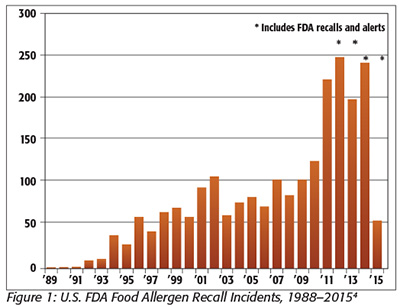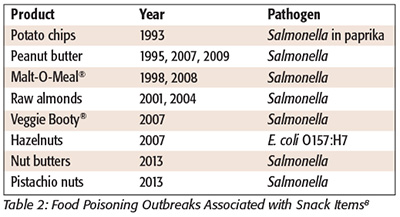If one listens to the “food police,” consumption of snack foods, be they salty snacks, crackers, cookies, cakes, nuts or fried foods, is risking your life because these things will cause diabetes, heart disease and a wide range of other illnesses. Food police working in school systems have tried to dictate what parents can place in their child’s lunchboxes. They have gone so far as to inspect what kids bring from home, confiscate cookies or other items and send the child home with a note telling the parents how terrible they are because they sent their child to school with cookies or chips. Schools have even gone so far as to ban bake sales, a time-honored fundraiser, or mandate what can be sold at said sales: no cakes, pies, cookies, cupcakes and such.
This is a nutritional debate that will linger for years. Yet, sometimes, the best messages are forgotten. Years ago when I was in grade school, I distinctly remember that the school nurse came into my class one day and emphasized the importance of a balanced diet and that moderation was the key to good health. This is something that people tend to forget: A little of something is not going to hurt you, especially, with children, if they are active and burning calories as fast as they take them in.
Another point the food police seem to forget is that we are people and have been gifted with the senses of taste and smell, plus an appreciation of textures of food. People must eat to live, but there are many who live to eat. Chips, crackers, cookies and other snacks appeal to the senses—they taste good and generally have a very pleasing texture, which is why people buy them again and again. This basic premise is the cornerstone of the food business: repeat purchases. Margins on most foods are quite low, so the manufacturers want people coming back. Personally, I enjoy the occasional snack item, whereas some of the alleged superfoods simply taste terrible, such as kale.
So, let’s put nutritional issues aside and simply acknowledge that snacks are and probably will remain an integral part of our diet simply because of their sensory attributes. Instead, let’s focus on whether snacks themselves pose any food safety risks.
Physical Characteristics
Let’s take a look at the physical characteristics of most snack foods. If we consider the following, what is the most common characteristic?
 • Chips (baked or fried)
• Chips (baked or fried)
• Crackers
• Cookies
• Nuts
• Breakfast bars
Answer: These products are all low in moisture. They have low water activity (see Table 1[1]) and simply will not support the growth of food pathogens or even spoilage organisms.
Snack foods are prone to oxidation and staling, but these are quality, not food safety, issues. These foods will simply not support the growth of pathogens. However, there are potential concerns that will be addressed later.
Ingredients, Including Allergens
Snacks are formulated with literally every ingredient under the sun. Most people tend to associate snacks with products such as wheat, rice, barley or other grains and seeds. How a snack food is formulated depends upon where in the world it is being produced and the target market. Here in the U.S., we are seeing more of the supposedly healthy grains and seeds going into snacks. Whether these new formulations will stand the test of time remains to be seen. Again, we get back to consumer acceptance. If a snack product tastes good and the company is committed to maintaining those qualities, the item will probably remain in the marketplace.
Because snacks are formulated with all kinds of ingredients, many contain allergens, so there are people who must avoid these items. The “Big Eight” allergens upon which the Food Allergen Labeling and Consumer Protection Act focuses must be clearly labeled on the package. There are two options:
• In the body of the ingredient statement, such as “Contains whey (milk)”
• In a separate statement, such as “Contains milk”
Of course, it is up to sensitive consumers to read the ingredients statement to protect themselves.
Processors manufacturing snack items have an obligation to develop, document, implement and maintain an allergen management program, which has long been an integral part of third-party audit schemes such as those approved by the Global Food Safety Initiative (GFSI) and private schemes managed by consulting firms. Allergen management will also be an element in the Food Safety Modernization Act (FSMA) Hazard Analysis and Risk-Based Preventive Controls program. How this will finally shake out remains to be seen, but we should know more details by August 30, 2015.
A company’s allergen management program should include but need not be limited to the following elements:
• Vendor approval
• Product development
• Proper labeling
• Receiving
• Warehousing and storage
• Production control
• Scheduling
• Cleaning and sanitizing
• Control of rework
• Product identification and recalls
• Education of management and staff
There have been a number of articles published in this magazine over the years that provide details on how to build and manage an allergen control program. Rather than discuss them here, the editor invites you to look to past editions.[2,3]
 But how well is the industry as a whole doing when it comes to allergen management? Not as well as it should if one looks at the statistics gathered by the Food Allergy and Anaphylaxis Network (see Figure 1[4]). There has been an upward trend in allergen recalls over the past 25 years, which indicates that the industry needs to do better. Fortunately, the majority of the recalls were initiated prior to anyone’s getting sick.
But how well is the industry as a whole doing when it comes to allergen management? Not as well as it should if one looks at the statistics gathered by the Food Allergy and Anaphylaxis Network (see Figure 1[4]). There has been an upward trend in allergen recalls over the past 25 years, which indicates that the industry needs to do better. Fortunately, the majority of the recalls were initiated prior to anyone’s getting sick.
Chemical Safety
As discussed, many snack items are grain- or seed-based. Are there significant chemical hazards associated with such products and the ingredients used to manufacture them? Processors should address mycotoxins when they conduct their hazard assessment of ingredients and finished goods. Most processors would deem the risk to be minimal.
Almost all snacks are cooked in some manner: baked, fried or oven-cooked. The heating process reduces water activity, helping ensure stability, imparts desirable sensory characteristics such as color and texture, and is deemed a kill step in some operations. There are other effects, however: the formation of acrylamide. Acrylamide is a naturally occurring byproduct of the cooking process and forms in a wide variety of foods, including coffee, chocolate, french fries, potato chips, cereal and even some fruits and vegetables. While acrylamide has been present in the human diet ever since we began cooking with fire, it was not known to be in food until 2002, when a group of Swedish scientists presented research that detected it in some baked and fried foods. Acrylamide forms naturally when high-starch foods are fried, baked or roasted at high temperatures. It also forms when foods are cooked at home and in restaurants as well as when they are made commercially. Since its intial discovery, there has been a flurry of research throughout the world on acrylamide. The U.S. Food and Drug Administration (FDA) and the World Health Organization have not determined whether this compound poses a health risk to humans and have, therefore, made no recommendations with regards to changing diets, but the European Union has developed a toolbox on acrylamide.[5]
The European Commission has issued guidelines for minimizing the formation of acrylamide in foods, including heating products to lighter colors and washing or blanching products prior to cooking to remove sugars. It really doesn’t matter whether the materials are conventionally grown or organic; acrylamide will form.
So, anyone producing snacks that are baked, fried or cooked in an oven should consider acrylamide formation in their Hazard Analysis. Depending upon the composition of the product and how it is produced, they can minimize its formation.
Processors producing fried snacks also should examine potential risks posed by abused frying oil. The results of the Hazard Analysis should indicate that the risk is quite low, since producing products in frying oils that are badly abused will compromise product quality and shelf life. In industrial frying operations, oil abuse is very rare. In fact, the German Society for Fat Science issued recommendations in 2000 that stated, “No health concerns with consumption of fats and oils that have not been abused.”[6,7]
Microbiological Safety
Earlier, we discussed how snack foods will not support the growth of food pathogens and should, therefore, be safe. Food safety is more than just formulation, however. A perfectly safe food, in theory, can become hazardous through mishandling, abuse after processing, the incorporation of contaminated ingredients or failure to properly manage certain processing steps. The best example and one that has been in the news in 2015 due to the sentencing of the company’s principals is the peanut butter products from the now-defunct Peanut Corporation of America. Peanut butter is a low-water activity product that will not support the growth of food pathogens, but if the pathogen gets into the product, the chances of getting it out are slim. The low water activity and high fat content will protect the organisms from heating and other challenges.
 Now, peanut butter and other nut butters might not be considered a snack item, but they are ingredients in many snack foods. If one looks at the recalls prompted by the problems at the Peanut Corporation of America and Sunland, a review of these records will show that many of the companies that were forced to conduct recalls produced snacks. There have been a number of food poisoning outbreaks associated with seemingly safe snack items (see Table 2[8]).
Now, peanut butter and other nut butters might not be considered a snack item, but they are ingredients in many snack foods. If one looks at the recalls prompted by the problems at the Peanut Corporation of America and Sunland, a review of these records will show that many of the companies that were forced to conduct recalls produced snacks. There have been a number of food poisoning outbreaks associated with seemingly safe snack items (see Table 2[8]).
There are a number of lessons to be learned from these different outbreaks, and the food industry has taken them to heart. The lessons learned from the Salmonella outbreaks attributed to raw almonds in 2001 and 2004 were quite profound. In response to these outbreaks, the Almond Board of California (ABC) mandated that all California almonds be processed to ensure that they are Salmonella-free. Products that are treated to achieve a 4-log reduction may be labeled as treated and those given a 5-log treatment may be called pasteurized. Most important, the processes necessary to achieve these reductions must be established by a process authority approved by the ABC and must be approved by a Technical Experts Review Panel (TERP), a group of food safety experts appointed by the ABC. At the moment, TERP has approved several methods for ensuring the lethality of processes for almonds,[9] which include oil roasting,[10] dry roasting, treatment with propylene oxide and steam processing.
The methods developed by the ABC were all based on solid scientific principles. The program has been extremely successful and has been copied by producers of other nuts. There has been one gap in this technology transfer, however. One simply cannot transfer a technology established for almonds to another nut without due diligence, that is, without fully validating the technology for that industry. That includes ensuring that bacteria used as surrogates for Salmonella on almonds are the correct surrogate for another nut.
Vendor Approval and Quality
One of the key elements of the third-party audit schemes approved by GFSI, ISO 22000 and private audit schemes is vendor quality. This is also an element of FSMA. A vendor quality program should consist of a means for identifying, evaluating, approving, maintaining an ongoing relationship and evaluating performance. If there is an area where processors slip up, it is in the evaluation phase or during maintenance.
The outbreak cited earlier in potato chips (see Table 2[8]) was due to contaminated paprika used as a seasoning. Since potato chips are fried in hot oil at temperatures in excess of 300 °F, they are basically sterile when they leave the fryer. Improper handling or application of contaminated seasonings could create an unsafe product. This is why processors need to pay attention to ingredient quality and to their vendors. I have been unable to discover any information on whether the potato chip manufacturer involved in this outbreak had a rigid vendor quality program, but given the year, 1993, I would have my doubts. Would such a program have prevented the outbreak? Maybe, maybe not. It would have certainly reduced the risk.
An integral part of the vendor quality program is identifying and evaluating potential vendors. A risk assessment should be done to evaluate not only the ingredient, but also its source and how the supplier handles those ingredients. Suppliers must provide specifications for all ingredients, but the buyer should also have established guidelines for what they will and will not accept. Basic acceptance criteria might be “Salmonella-free at a certain sample size” and that the material be passed through a metal detector either in the final package or immediately before packaging. Today, most buyers mandate that the supplier provide a Certificate of Analysis (COA) with each lot that they purchase. This is one area where vendor programs differ. Some buyers mandate that the COA for each ingredient be verified upon receipt. What is done to verify the COA should be based on risk. A high-risk ingredient might be tested for Salmonella and Listeria monocytogenes prior to its being allowed onto the production floor. An incident like the paprika contamination would raise the risk rating and should move the ingredient into a category where it is tested more often.
So, the bottom line is that snack food producers, especially those that use seasonings on products after cooking or frying, must have a well-documented vendor quality program. Yes, something could sneak through, but the odds are much less if one has a program, the more rigid and demanding the better.
Processing and Process Validation
The programs that have been established by the ABC to ensure the safety of almonds were discussed earlier. The goal of the ABC is to ensure that all California almonds receive a process sufficient to achieve a 5-log reduction of Salmonella Enteritidis. Almonds are only one type of the many snacks that have been alluded to in this article. What about cookies, fried chips, crackers, breakfast bars and the many other snacks that are produced? As we have said, most of these products have been heated in some way, shape or form. For many years, processors operated under the assumption that the products were safe since they were heated. But is this a valid assumption to make? Probably not for all products in the snack category. And processors are aware that this is the case. There is an ongoing effort in the snack industry to evaluate current processes and determine their efficacy when it comes to pathogen control. Process validation is one element that FDA will look at when the regulations for enforcement of FSMA are finalized. Will the processes given to snacks receive the same scrutiny as those given to products deemed to be higher-risk items? That is unknown at the moment.
If one looks at the processes currently used in the industry—frying, baking, continuous oven cooking and dry roasting—it is probably safe to say that if a company is frying or oil-roasting their products, they are safe. The Almond Board’s “Guidelines for Oil Roasting” are 260 °F for 2 minutes.[10] Most oil-roasting or frying operations use considerably higher temperatures that will enhance lethality.
However, what about the other products and processes? Some of these products may be a challenge, especially those products that incorporate inclusions such as chocolate chips, peanut butter chips, nuts or other pieces. Will these inclusions heat at the same rate as the rest of the snack? Processors also need to consider how the product will affect the death rate of pathogens. We have already talked about how peanut butter can protect Salmonella. Pathogens tend to be more resistant in products with lower water activity and those that contain higher levels of fats or oils, so these questions need to be considered when evaluating a process.
If one is producing such products, the manufacturer may have to focus more on vendor quality so that they are confident that all the components making up their snack food are safe and that their processes are designed to minimize the potential for contamination at all points in the process from batching through to packaging.
Summary
So, are snacks safe? Even though parts of this article point out potential hazards in this product category, snacks are one of the safest foods in the market. However, processors must make a commitment to ensuring that their products remain so. Food safety is not simply a function of the product and the process, but must include a commitment to ensuring the safety and quality of raw materials and ingredients, working to better understand and preferably develop data to validate processes and to developing, documenting, implementing and maintaining the food safety systems to protect your customers, your company and your brand. Maintenance of these systems falls squarely on the heads of top management. They are the ones who must provide the resources to ensure that every employee understands the importance of safe food and that the company has the tools to carry out this task. When management fails to adhere to this rule, problems may occur. All we need to do is look at what occurred at the Peanut Corporation of America to see what a management failure can do.
Richard F. Stier is a consulting food scientist with international experience in food safety. He is a member of the Institute of Food Technologists and a member of the Editorial Advisory Board of Food Safety Magazine. He can be reached at rickstier4@aol.com.
References
1. www.fda.gov/downloads/Food/GuidanceRegulation/UCM252447.pdf.
2. Stier, RF. 2008. Building a world-class allergen control program: Part 1. Food Safety Magazine 14(5):28–31, 56.
3. Stier, RF. 2008. Building a world-class allergen control program: Part 2. Food Safety Magazine 14(6):24–27, 50.
4. Food Allergy and Anaphylaxis Network. 2015. USFDA Food Allergen Recall Incidents 1988–2015. Table used with the permission of FARRP.
5. www.fooddrinkeurope.eu/uploads/publications_documents/AcrylamideToolbox_2013.pdf.
6. Stier, RF. 2007. Ensuring the safety and quality of fried foods. Food Safety Magazine 13(3):30–35, 66–68.
7. German Society for Fat Science. 2000. Recommendations for the 3rd International Symposium on deep-fat frying – Optimal operation. Euro J Lipid Sci Tech 102(8–9):594.
8. Lehmacher, A, J Bockemuhl and S Aleksic. 1995. Nationwide outbreak of human salmonellosis in Germany due to contaminated paprika and paprika-powdered potato chips. Epidemiol Infect 115, 501–511.
9. www.almonds.com/sites/default/files/content/attachments/proprietary-processes.pdf.
10. www.almonds.com/sites/default/files/content/attachments/oil-roast-validation-guidelines.pdf.
How Safe Are Snack Foods?




